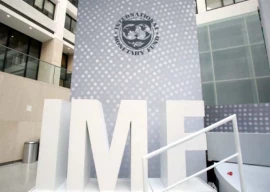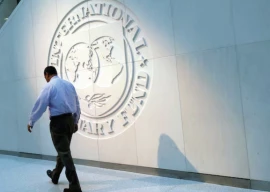
The government has succeeded in ensuring the sustainability of the external and fiscal sectors through various tough decisions and stabilisation measures in FY2023.
In FY2024, the government is gearing towards achieving higher growth of 3.5 per cent through various measures like the Kissan package, industrial support, export promotion, encouragement of the IT sector, and resource mobilisation, etc., according to the Monthly Economic and Update and Outlook Monthly report issued by the Ministry of finance here on Wednesday.
According to the report, achieving higher and sustainable economic growth will require prudent and effective economic decisions, political and economic certainty, and continuation of friendly economic policies along with enough foreign exchange financing.
The recent IMF approval of the stand-by arrangement and other bilateral and multilateral inflows will pave the way to further improve the macroeconomic environment and the confidence of economic agents.
Despite of substantial decline in imports, the LSM and the overall slowdown in economic activity, the government’s effective resource mobilisation strategy remained effective in maintaining the Federal Board of Revenue (FBR) tax collection growth at 16.6 per cent, while non-tax grew by 31 per cent, the report said.
Read more: Businessmen warn of mass industrial shutdowns
Similarly, on the expenditure side, though mounting interest expenditure remained a significant burden on fiscal accounts, curtailing non-interest spending triggered a primary deficit to narrow down.
For FY2024, the government is taking various measures for domestic resource mobilisation. The government has unveiled a comprehensive strategy for every sector of the economy in an effort to revive economic growth and move towards a higher inclusive and sustainable growth trajectory.
Further different administrative and policy measures have been introduced to increase the tax collection.
Additionally, SBP’s withdrawal of restrictions on imports will create demand for imports. All these measures will be supportive in improving the revenues, the report added.
On the expenditure side, various austerity measures are in place that will be helpful in reducing non-productive expenditures.
About the overall economic activity, the Monthly Economic Indicator (MEI) is developed as a tool to distribute the past annual GDP numbers, as reported by the PBS, on a monthly/quarterly basis, and to now cast on that same frequency GDP growth for the FY in which the national accounts are not yet available, the report said.
The MEI calculated for July 2022 to June 2023 is well aligned with the newly published national accounts for FY2023.
It indicates that since April, MEI, following the upward trend, is showing signs of improvement and is expected to be positive in the coming months.
According to the report, FY2023 was a challenging fiscal year, however, it has witnessed noteworthy fiscal and current account balance improvements.
Also read: Banking spreads reach 20 year high
The government’s stern decisions and stabilisation measures have steered the country towards a sustainable path.
The growth targets of 3.5 per cent are anticipated to be met through Kissan package, industrial support, export promotion, encouragement of the IT sector, and resource mobilisation efforts.
On the global front, the economic activity in major advanced economies is still showing signs of weakness, mainly due to the continuation of monetary tightening measures.
Inflation has fallen in some economies due to lower energy prices, but food and services prices continue to rise, contributing to the persistent high inflation. Monetary tightening measures are still in place. Consumer Price Index (CPI) inflation has declined to 29.4 per cent in the month of June 2023 from 38.0 per cent recorded in May 2023.
The food inflation (urban) has declined from 48.1 per cent to 40.8 per cent. The sensitive price indicator (SPI) also declined by 0.07 per cent on the week ended July 20, 2023.
The fiscal front has seen an important improvement, with the primary deficit reducing significantly from Rs945.3 billion last year to Rs112 billion during July-May FY2023.
Decline in fiscal deficit
Furthermore, the fiscal deficit is also expected to decline from the previous year 7.9 per cent of GDP, largely due to a 12 per cent reduction in non-markup spending.
In order to contain persistently rising inflationary pressures and to maintain external sector stability, SBP had to increase the policy rate by 100 basis points to 22 per cent in its last monetary policy committee meeting.
The current account deficit has also declined by 85.4 per cent as compared to the last year. The current account has posted a deficit of $2.6 billion for FY2023, a reduction from the previous year’s deficit of $17.5 billion.
According to the report, the current account has improved, resulting in a surplus of $334 million in June 2023.
OECD economic outlook estimated global growth to be 2.7 per cent in 2023, with a modest pick-up to 2.9 per cent in 2024 – both well below the average growth rate in the decade preceding the Covid-19 pandemic.
Global GDP growth slowed substantially throughout 2022, but several of the factors weighing negatively are now unwinding.
Falling energy prices and headline inflation, easing supply bottlenecks and the reopening of China’s economy coupled with strong employment, all contribute to a projected recovery.
Significant uncertainty about economic prospects remains, and the major risks to the projections are on the downside.
One key concern is that inflation could continue to be more persistent than expected. Emerging market economies face challenges from tight global financial conditions: higher debt servicing costs, capital outflows, and reduced credit availability from foreign lenders, the report said.
Moreover, rising geopolitical tensions and concerns about supply chain security have prompted several countries to implement trade and investment restrictions.
Increasingly restrictive trade policies risk curtailing the gains from global trade and harming the development prospects of low-income countries.
Asian Development Outlook for July 2023 projects Asia’s outlook optimistic, as China’s reopening and domestic consumption and investment continue to underpin growth in the region, the report said.
The regional growth forecast is maintained at 4.8 per cent for 2023 and marginally revised downward to 4.7 per cent for 2024.






















COMMENTS
Comments are moderated and generally will be posted if they are on-topic and not abusive.
For more information, please see our Comments FAQ